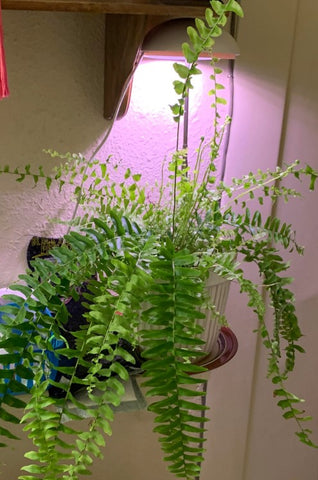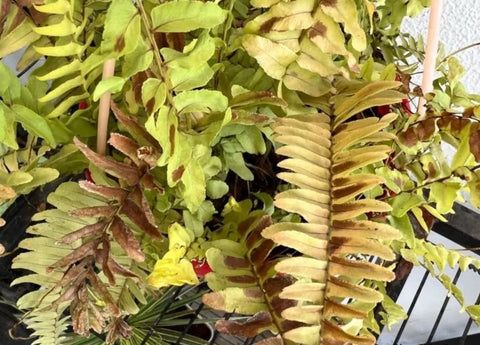Boston Fern Light Requirements: How Much Light Does a Boston Fern Need?
Boston ferns (Nephrolepis exaltata) are popular indoor plants with graceful, sword-shaped fronds and air-purifying qualities. Originating from tropical regions, this beautiful pet-safe plant thrives in environments with high humidity and consistent indirect sunlight, whether you’re planting it indoors or outdoors.
But how much light does a Boston fern need?
Boston ferns prefer moderate to high levels of bright, indirect light. They can tolerate lower light conditions too, but may not grow as vigorously or produce as many fronds.
This guide will help you find the perfect balance between light intensity and duration, keeping your Boston fern happy and thriving.
About Boston Ferns

Boston ferns, native to tropical regions like South America, are renowned for their plush arching fronds. These types of ferns are prized for their aesthetics, particularly when displayed in hanging planters, where their sword-shaped leaves can cascade elegantly. Beyond their visual charm, Boston ferns also act as natural air purifiers, filtering out toxins and pollutants, and thus, improving the air quality. Their love for humidity makes them excellent plants for bathrooms or kitchens, where moisture levels usually tend to be higher.
With the right care, this bushy fern can thrive as a stunning addition to any indoor or outdoor space.
How Much Light Do Indoor Boston Ferns Need?
Indoor Boston ferns need at least a couple of hours of bright, filtered light daily to thrive. Prolonged direct light exposure will cause sunburn, but they won’t survive in the total shade either.
What Kind of Light Does a Boston Fern Need?
Houseplants like Boston ferns stay cheerful in bright, indirect light, making them ideal for areas with filtered sunlight or near windows with sheer curtains. Given the fact that they favor consistent moisture and humidity, bathrooms and kitchens with good ventilation are other suitable indoor locations for these tropical wonders.
Boston Fern: Light Requirements Outside
When it comes to Boston fern’s outdoor light requirements, it prefers partial to full shade. This makes it suitable for areas with dappled sunlight or partially shaded spots in gardens or on patios, where it can bask under indirect light.
Is My Boston Fern Getting Enough Light?

A Boston fern getting enough sunlight will display vibrant foliage with deep green leaves. Its fronds will appear full and robust, with no signs of wilting or discoloration. Your plant will also exhibit healthy growth, with new fronds showing up regularly.
Additionally, the overall appearance of the fern will be rich and dense, with no sparse areas or yellowing leaves.
Boston Fern: Signs of Too Little Light
If you suspect your Boston fern is getting too little light, the following signs will confirm it:
Can Boston Ferns Take Full Sun?

No, Boston ferns can’t take full sun. They generally prefer bright, indirect sunlight to prevent sunburn and damage to their fragile fronds.
Boston Fern Sunburn: Signs and Fixes
Watch out for these signs of Boston fern sunburn and learn how to fix them:
Boston Fern: Seasonal Care & Maintenance

It’s essential to adapt your Boston fern’s care routine to the current season, be it the cold winter or scorching summer.
What Do I Do With My Boston Fern in the Winter?
Taking good care of your Boston ferns in the cooler months is key if you want it to thrive again in the growing season. The first thing to do is to move your fern indoors if it’s been kept outside in the summer months.
For indoor-grown Boston ferns, all-year round, check if the current location of the plant receives sufficient bright, indirect light, as the winter sun is much weaker. Try to maintain a consistent warm temperature indoors, avoiding drafts and cold spots. Water your thirsty Boston fern as and when required, allowing its soil to partially dry out between watering sessions.
Lastly, reduce your fertilizing frequency, as the plant's slows down its growing rate during the cooler months.
Boston Fern: Summer Care Tips
Follow these care tips to ensure your Boston fern thrives in the hot summer season:
- Ensure consistent moisture for your plant by watering and misting it regularly.
- Maintain medium to high humidity levels around the plant.
- Provide bright, indirect sunlight and avoid direct exposure to intense midday sun to prevent scorching.
- Move your Boston fern in the shade or indoors if the outside temperature soars above 75°F (or 24°C).
- Monitor your fern for pests like spider mites or aphids, and use natural or chemical insect control methods if necessary.
Boston Fern Light Requirements: FAQs
Q: Can a Boston fern live in a dark room?
A: Yes, a Boston fern can live in a dark room, such as a garage, basement, or shed provided it gets light from an artificial source.
Q: Do Boston ferns do well in heat?
A: Boston ferns can’t tolerate heat much, with 75°F being the upper limit for their comfort. If exposed to a higher temperatures, your plant’s fronds may start to wilt, develop brown tips, or dry out more quickly.
Q: Can Boston ferns tolerate low light?
A: Boston ferns, being tropical in nature, won’t thrive in low light. They require at least a couple of hours of bright, filtered sunlight each day.
Q: Why is my Boston fern sad?
A: Your Boston fern may be unhappy because of underwatering or overwatering issues, inadequate humidity, overexposure to direct sunlight, insect problems, and more.
Q: Where do you put a Boston fern outside?
A: If you’re planning to plant a Boston fern outside, choose a spot where it’ll get constant filtered sunlight through the cracks in a porch roof or tree branches. It can be the ideal front door hanging plant, too.
Conclusion
Whether you already own a Boston fern or are planning to bring home one, it’s crucial to understand the plant’s optimal light requirements for its overall vitality.
These easy-care plants are fond of bright, indirect light, making both indoor or outdoor spots with filtered sunlight or partial shade perfect for them. Avoiding low light is key, as it can lead to stunted growth and a leggy appearance.
Spruce up your indoor garden even more by growing companion plants like a money tree, fiddle leaf fig tree, or Chinese money plant together with your Boston fern plant.












Leave a comment